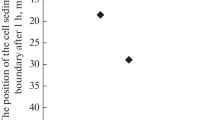Abstract
The parameters of controlling the separation of erythrocyte and lymphocyte cells were studied; the possibility of rapid (minutes) separation of blood cells into fractions in the field of a standing ultrasound wave was shown. Seven main control parameters were identified; they were related to the energy of the field of the standing ultrasonic wave, the linear pumping rate of the cell suspension, the geometric dimensions of the cells, the ratio of cell densities and suspending media, and the ratio of ultrasound velocities in the cell material and suspending media. It was shown that under effective temperature control of the chambers of the ultrasonic separation and concentration systems with a suspension of cells, it is possible to significantly (by more than an order of magnitude) reduce the time of separation and concentration of cells not only of different types, but also of similarly-sized cells of the same type isolated from the blood of different animal species.






Similar content being viewed by others
REFERENCES
N. S. Bardell, J. Sound Vib. 174, 655 (1994).
J. J. Hawkes and W. T. Coakley, Sens. Actuators, B 75, 213 (2001).
C. M. Cousins, J. R. Melin, W. A. Venables, and W. T. Coakley, Bioseparation 9, 343 (2001).
R. Bosma, W. A. van Spronsen, J. Tramper, and R. H. Wijffels, J. Appl. Phycol. 15, 143 (2003).
G. D. Pangu and D. L. Feke, Chem. Eng. Sci. 64, 1445 (2009).
T. Franke, S. Braunmuller, L. Schmid, et al., Lab-on-a-Chip 10, 789 (2010).
T. Franke, A. R. Abate, D. A. Weitza, and A. Wixforth, Lab-on-a-Chip 18, 2625 (2009).
D. Foresti, N. Bjelobrk, M. Nabavi, and D. Poulikakos, J. Appl. Phys. 109, 093503 (2011). https://doi.org/10.1063/1.3571996
G. R. Goddard, C. K. Sanders, J. C. Martin, et al., Anal. Chem. 79, 8740 (2007).
N. N. Knyaz’kov and G. V. Shil’nikov, Bull. Exp. Biol. Med. 121, 287 (1996).
N. N. Knyaz’kov, E. D. Makarova, and A. D. Rabizhanovich, Sci. Instrum. 19, 40 (2008).
V. A. Shutilov, Basic Physics of Ultrasonic (Leningrad. Gos. Univ., Leningrad, 1980), pp. 114–117.
L. B. Kheifets and V. A. Abalakina, Lab. Delo, No. 10, 579 (1973).
J. C. Fiala, in Proc. Int. Joint Conf. on Neural Networks (Honolulu, HI, 2002), pp. 1–4.
T. N. Pashovkin and D. G. Sadikova, Acoust. Phys. 55 (4–5), 584 (2009).
Author information
Authors and Affiliations
Corresponding author
Ethics declarations
Conflict of interest. The authors declare that they have no conflicts of interest.
All applicable international, national and institutional principles for the care and use of animals in the performance of work have been observed. The procedures performed in the study with the participation of people corresponded to the ethical standards of the Helsinki Declaration of 1964 and its subsequent amendments. Informed voluntary consent to participate in the study was previously obtained from all participants.
Additional information
Translated by E. Puchkov
Abbreviations: LUS, longitudinal ultrasonic selection.
Rights and permissions
About this article
Cite this article
Pashovkin, T.N., Sadikova, D.G. Control Parameters for Separation and Concentration of Rat Erythrocytes and Lymphocytes and Human Erythrocytes in the Field of a Standing Ultrasonic Wave. BIOPHYSICS 67, 445–450 (2022). https://doi.org/10.1134/S0006350922030174
Received:
Revised:
Accepted:
Published:
Issue Date:
DOI: https://doi.org/10.1134/S0006350922030174



